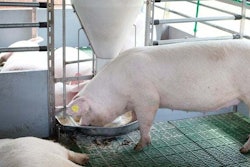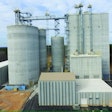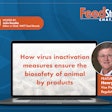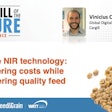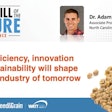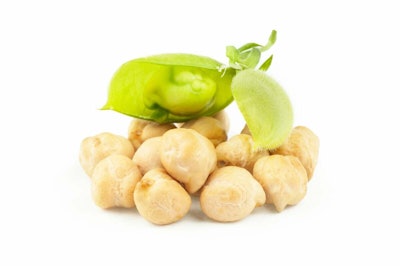
Genome-guided breeding drives chickpea ingredient solutions to new heights
Chickpeas, a centuries-old staple of Middle Eastern cuisine, may reach notoriety in the Western world as a leading animal protein alternative ingredient. With qualities like a nutty flavor, grainy texture andhigh protein content, chickpeas are hailed as the ideal replacement for meat in vegan and vegetarian diets, or for anyone seeking to reduce their animal protein consumption.
Chickpeas have been cultivated in the Mediterranean region for thousands of years, but North American production was minimal until recently. As theappetite for plant-based food optionsin the U.S. increased throughout the past decade, so has demand for chickpea production.
According to the nonprofit trade associationUSA Pulses, the number of chickpea-producing states grew to nine in 2022: California, Colorado, Idaho, Montana, Nebraska, North Dakota, Oregon, South Dakota and Washington.
With an array of applications beyond meat alternatives — they can be eaten whole, ground into butter or dip, or processed intoflour for bread, pasta or crackers— chickpeas are poised to play an important role in sustainable food and feed production in the coming decades.
AgTech startup NuCicer pioneers chickpea innovation
NuCicer, an ag tech business spin-out ofUniversity of California, Davis, created chickpeas that have more than 75% protein than conventional chickpeas. Combining machine learning and genome-guided breeding to match chickpeas with genetically diverse crops — picking those that generate a better crop than the sum of its parts — NuCicer set out to revolutionize the plant protein industry.
Feed & Graineditor Elise Schafer sat down with NuCicer’s CEO and co-founder, Kathryn Cook, for insights into how NuCicer reduces chickpea protein ingredient costs by 50% while expanding work with downstream partners to bring affordable, sustainable plant proteins to end consumers.
Elise Schafer, editor of Feed & Grain: How does the higher protein content in NuCicer chickpeas contribute to food supply chain sustainability?
Kathryn Cook, CEO and co-founder of NuCicer:Increasing protein content in chickpea contributes to food sustainability at two major steps in the supply chain. At the grower level, NuCicer’s high-protein varieties allows more protein to be produced per acre, which reduces farming inputs on a protein per-gram basis. At the protein ingredient production level, starting with higher protein content helps reduce the amount of energy and water needed to produce a protein concentrate or isolate.
Schafer: What are some other key differences between NuCicer chickpeas and traditional soy-based protein ingredients?
Kathryn Cook, CEO and co-founder of NuCicer (Courtesy NuCicer)
Cook:Chickpea protein is known for its mild flavor and aroma, as well as strong functional attributes. This reduces the need for additives and masking agents to achieve end-product texture and flavor profiles. NuCicer chickpeas maintain the desired attributes of commodity chickpeas while increasing the protein content to bring down cost and improve environmental resilience at the crop level.
Schafer: What human food applications are chickpea protein ideally suited for?
Cook:Chickpea flour works great in baked goods, pastas and snack foods as the result of its mild flavor and nutritional protein and fiber content. Chickpea protein ingredients are ideal for sauces and dips, alternative dairy products, and meat substitutes.
Schafer: What regions of the U.S. or world are ideal for growing chickpeas?
Cook:鹰嘴豆喜欢温暖和中期生长条件to low humidity levels. They are typically grown in the Northwestern region of the U.S. and into the Saskatchewan region of Canada in early to mid-spring and harvested at the end of the summer.
Schafer: Could NuCicer’s machine learning and genome-guided breeding platform be used to increase the protein content of other crops?
Cook:As NuCicer’s technology identifies regions of the genome that support increased protein content and other key traits, there may be opportunities to support improvements across other members of the legume family.
Schafer: What is your outlook on chickpea production and processing expansion over the next five to 10 years?
Cook:Environmental resilience is critical in supporting a stable global food production system. Chickpea is already a sustainable crop known for its water-use efficiency and nitrogen fixation capacity. NuCicer’s technology will take chickpeas further, improving key traits for environmental resilience, such as tolerance to heat and acidic soils. These improvements combined with chickpea’s adaptable nature as a food ingredient make it a hero crop for our future and will drive production expansion over the next decade.
NuCicer’s technology harnesses the natural biodiversity of wild chickpeas with its cutting-edge, genomic breeding platform to create value throughout the food system.
Thanks to funding byLeaps by Bayer, the impact investment arm ofBayer, NuCicer will bring high-protein chickpea ingredients to market in 2023 and expand its technology platform to develop products with greater climate resilience.
Read on for more facts about how humans, livestock and pets can benefit from chickpeas — an eco-friendly, gluten-free superfood.
What you need to know about chickpeas
They’re pulse crops
Members of the legume family, pulses are the edible seed portion of annual crops like lentils, dry peas, beans and chickpeas. The term “pulses” is reserved for crops harvested solely as dry grain, as opposed to other vegetable crops that are harvested still green.
Pulses grow in pods, yielding between one and 12 grains or seeds each, and come in a variety of shapes, sizes and colors.
They’re thousands of years old
Chickpeas, or garbanzo beans, are among the oldest cultivated legumes known to man. Traces of7,500-year-old chickpeashave been discovered in the Middle East, pre-dating even the first time humans made pottery.
They’re sustainable
Nitrogen fertilizer application is a leading cause of greenhouse gas emissions in crop production. Chickpea production is more sustainable because pulses create their own fertilization by pulling nitrogen from the air into the soil.
Pulses support a healthy and diverse farm system and ecosystem, enrich soil health by leaving behind nutrients and beneficial microbes for the next crop, and decrease the risks farmers face from environmental and market fluctuations. Due to the low carbon footprint of chickpea and other pulse crop production, the United Nations declared 2016 the International Year of Pulses.
They’re high in protein
One cup of canned chickpeas contains around 11 grams of protein — that’s more than an 8-ounce cup of whole milk at 8 grams of protein and one large egg with 6 grams. But while chickpeas beat dairy and non-dairy milk, sweet potatoes and quinoa in terms of protein content, black beans and lentils come in as the leading legumes for protein density.
They’re used in animal feed
In addition to human consumption, chickpeas are used in animal feed for protein energy. Raw chickpeas have been revealed to be healthier for livestock than other legumes, such as peas.
Research shows that chickpea protein has no adverse effects on cows, allowing them to grow and produce milk equally as well as those fed soy or cereal. Chickpea protein has also been increasingly added todog and cat foodrecipes during the past several years as the grain-free pet food movement continues.
Chickpeas are among the fastest-growing ingredient additions to human food, animal feed and pet food. With ancient roots and myriad modern-day applications, this sustainable pulse crop will soon reach its full potential as an alternative protein ingredient for consumers and animal agriculture producers worldwide.
Feed Mill of the Future digital supplement
WATT’s feed brands Feed Strategy and Feed & Grain magazines join forces to launch the monthly Feed Mill of the Future digital supplement. Each edition aims to provide animal feed industry stakeholders with forward-looking content, market insights and a spotlight on the leading-edge technologies shaping the global feed industry of tomorrow.
Subscribe today!https://bit.ly/3dWzow7







